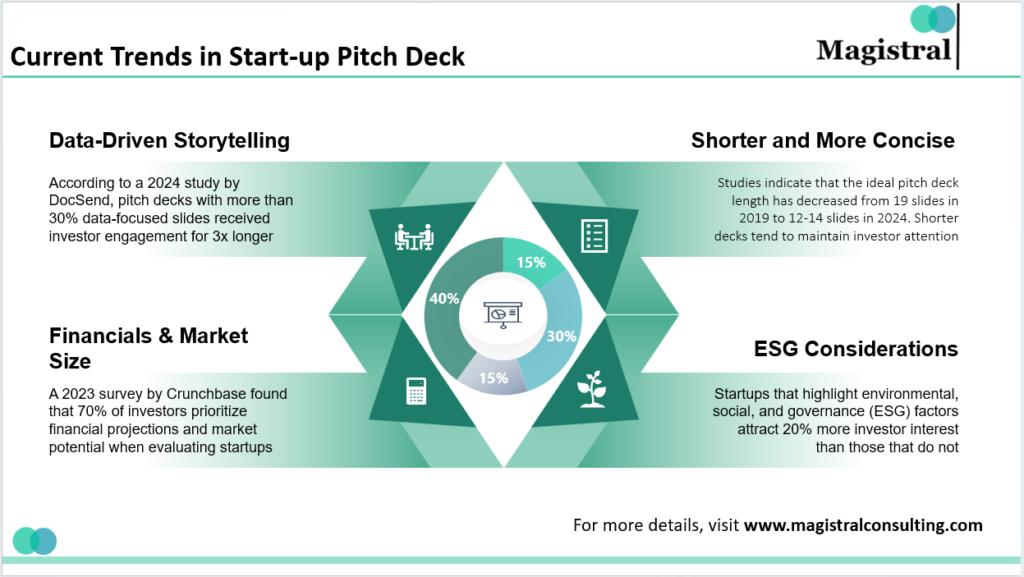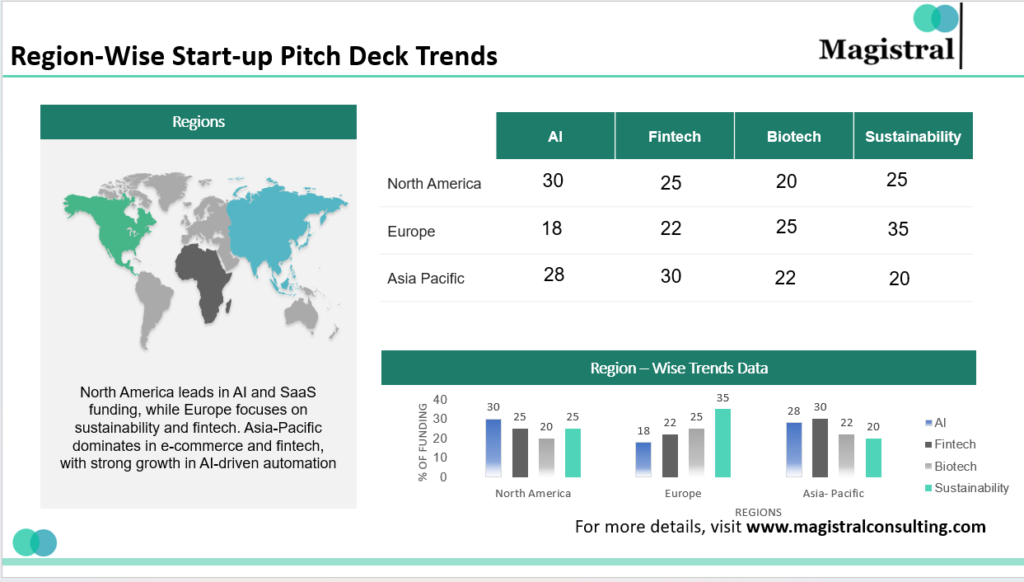The power of presentation is paramount in the dynamic startup ecosystem, where exceptional concepts are insufficient. Complete Pitch Deck Support has become a critical enabler, assisting founders in the development of compelling, fundable narratives that resonate with investors.
A Strategic Imperative: Comprehensive Pitch Deck Support
Negotiating your way through the murky waters of a new startup is no easy feat, and having a well-pitch deck supports Startup Genome, 92% of firms fail to obtain follow-on funding due to a lack of presentation materials.
In the interim, CB Insights reports that 38% of ventures falter as a result of inadequate funding. Structure, narrative, and clarity are provided by the Complete Pitch Deck support to convert investor interest into tangible capital.
Key Catalysts Behind Rising Demand
The demand for narratives that are investor-ready has increased. As funding becomes more difficult to secure. Startups must no longer depend on minimal or generic decks; it is imperative to provide comprehensive Pitch Deck in order to differentiate themselves, establish credibility, and expedite fundraising results. A more challenging fundraising environment necessitates more robust decks.

Key Catalysts Behind Rising Demand
Rising Investor Scrutiny
The number of available transactions has decreased as a result of the 51% decrease in global VC funding from $582B in 2021 to $285B in 2023 (KPMG Venture Pulse Q4 2023). It is now imperative that entrepreneurs receive comprehensive Deck support in order to ensure that their investor-ready storytelling is in alignment with pertinent metrics, thereby distinguishing them from the crowd.
Perspective: The average duration of time that venture capitalists spend examining a pitch deck has decreased from four minutes in 2022 to three minutes and 44 seconds (DocSend 2023 Pitch Deck Report).
The Transition to Data-Driven Narratives
Data must be the foundation of contemporary startup storytelling. According to PitchBook, 67% of successful seed-round presentations encompassed explicit financials, market size, and go-to-market plans. The support of a complete pitch deck allows founders to proactively respond to investor inquiries through strategic narrative that is replete with data.
Key Components of an Effective Pitch Deck
It is crucial to comprehend that a successful deck must provide both clarity and persuasion prior to delving into the specifics. The most effective comprehensive Pitch Deck support solutions concentrate on the development of components that are consistent with the psychology of investors and align with business logic.

Pitch Deck Support: Effective Components
Clearly Defined Market Opportunity and Problem Statement
Startups must explicitly specify the issue they address and exhibit market potential. “Addressable market size” is a critical decision factor for 72% of VCs, according to EY-Parthenon. Support for the complete pitch deck guarantees that the pain points are not only articulated but also quantified using the TAM/SAM/SOM frameworks.
Fortune Business Insights anticipates that the global mental health tech market will reach $23.3 billion by 2030, with a compound annual growth rate (CAGR) of 16.5%.
Transparent Business Model and Monetization
According to McKinsey, 59% of early-stage investors decline proposals that lack a transparent revenue model. Founders can confidently and accurately present financial levers such as MRR, CAC, and LTV with the assistance of a Complete Pitch Deck.
Go-to-Market Strategy with Execution Readiness
A GTM strategy that is ostentatious but lacks realistic execution frequently fails. Bain & Company discovered that 50% of product disasters are the result of GTM misalignment. A proposal document that is well-supported should include a comprehensive GTM plan, which includes personas, sales channels, and cost projections.
Milestones and Progress Based on Evidence
Startups that demonstrate robust pre-revenue indicators, such as user growth and pilot consumers, are 3.5 times more likely to secure funding (Crunchbase 2024). The strategic highlighting of such proof elements is guaranteed by the Complete Deck support, which is designed to foster trust.
Grounded Financial Forecasts
Decks that are 60% more likely to secure funding are those that are supported by explicit assumptions and three-year projections, as per PwC. Tailored modeling of revenue, waste rate, and even adverse scenarios is included in the comprehensive Pitch Deck support.
From Good to Great: The Impact of Expert Pitch Deck Crafting
Design is not the sole aspect of Complete Pitch Deck support. It pertains to the development of a strategic, persuasive experience that motivates investor action. To the process, experts contribute objectivity, profundity, and investor insight.
Improving Investor Retention and Visual Communication
Professionally designed visuals enhance message retention by 67%, according to research conducted at Stanford University. Expert Pitch Deck support transforms complex data into infographics, timelines, and visuals that maintain investor attention.
Competitive Benchmarking to Demonstrate Distinction
Comparing businesses is an ongoing activity for investors. Experts who provide comprehensive support utilize benchmarking tools such as Statista and PitchBook to emphasize their strategic advantages.
For instance, a SaaS startup has discovered that its CAC is 22% lower and its retention is 18% higher than that of its rivals. These insights provide a competitive advantage in the market.
Customizing Decks for Investor Archetypes
Different value signals are sought by VCs, entrepreneurs, and family offices. High-quality Pitch Deck support customizes content according to investor persona, industry dynamics, and stage-specific outcomes, such as ecosystem fit or departures.
What is it’s future?
The field of startup fundraising is undergoing a swift transformation. Balancing automation with strategy, data with design, and personalization with scalability is the key to the future of it.
AI Is Revolutionizing the Workflow—But It Is Not Replacing Expertise
AI tools such as Beautiful.ai, Tome, and Canva Deck expedite creation. Nevertheless, strategic experts deliver irreplaceable value through comprehensive Pitch Deck support, grounding it in strategic logic and investor insights. While AI facilitates the narrative process, it does not direct it.
The Emergence of Interactive, Data-Driven Presentation Formats
According to the 2024 Digital Investor Trends report by Deloitte, interactive presentations are now preferred by one-third of investors. These decks include live demonstrations, dashboards, and data room access. Such formats are already being integrated.
VC Dry Powder Indicates Opportunity
Global VC dried powder is valued at $580 billion as of 2024 (Preqin). Startups with investor-grade, comprehensive Pitch Deck support will be distinguished when capital is reactivated. The aperture may be overlooked by individuals who lack clarity or a compelling structure.
Magistral Consulting’s Services for Pitch Deck Support
Magistral Consulting offers comprehensive services to assist startups and investment firms in creating compelling pitch decks that effectively communicate their value propositions to potential investors.
Strategic Narrative Development
Magistral works with clients to craft a persuasive and coherent narrative that highlights the problem they address, their solution, market opportunities, and unique value proposition.
Visual Design and Branding
Understanding the importance of visual appeal, Magistral designs pitch decks that are not only informative but also aesthetically engaging. This includes the creation of custom graphics, charts, and layouts that align with the startup’s branding, ensuring consistency and professionalism throughout the presentation.
Financial Modelling and Projections
Magistral provides detailed financial modelling services to project revenues, expenses, and cash flows. These models help in demonstrating the startup’s financial viability and growth potential, offering investors a clear picture of expected returns and financial health.
Market Research and Competitive Analysis
To substantiate the business case, Magistral conducts thorough market research, including industry trends, market sizing, and competitive analysis. This data-driven approach ensures that the pitch deck presents a well-rounded view of the market landscape and the startup’s positioning within it.
Investor Outreach and Fundraising Support
Beyond pitch deck creation, Magistral assists in identifying and reaching out to potential investors. Leveraging a proprietary database of over 25,000 investors, they help startups connect with suitable funding sources, streamlining the fundraising process.
Supporting Documentation Preparation
Magistral aids in the preparation of essential supporting documents such as investment memos, teasers, and executive summaries. These materials complement the pitch deck, providing investors with comprehensive information to facilitate decision-making.
About Magistral Consulting
Magistral Consulting has helped multiple funds and companies in outsourcing operations activities. It has service offerings for Private Equity, Venture Capital, Family Offices, Investment Banks, Asset Managers, Hedge Funds, Financial Consultants, Real Estate, REITs, RE funds, Corporates, and Portfolio companies. Its functional expertise is around Deal origination, Deal Execution, Due Diligence, Financial Modelling, Portfolio Management, and Equity Research
For setting up an appointment with a Magistral representative visit www.magistralconsulting.com/contact
About the Author
The article is authored by the Marketing Department of Magistral Consulting. For any business inquiries, you can reach out to prabhash.choudhary@magistralconsulting.com
An effective pitch deck must cover a clear problem statement, market opportunity, transparent business model, GTM strategy, data-driven milestones, and financial projections. These components align with investor expectations and improve fundraising outcomes. Magistral offers end-to-end support including strategic narrative building, visual design, financial modeling, market research, investor outreach, and documentation. Their services help startups present their value proposition with clarity, professionalism, and strategic depth. No. While AI tools like Beautiful.ai and Tome accelerate design, they lack the strategic insight and investor alignment that expert support provides. Human expertise is still crucial for crafting persuasive narratives and positioning startups effectively in a competitive landscape. What key elements should a high-impact pitch deck include?
How does Magistral Consulting support startups in creating investor-ready pitch decks?
Is AI replacing the need for expert pitch deck support?




